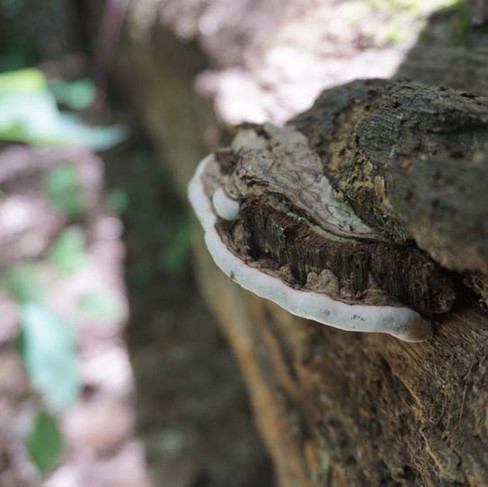Good afternoon friends,
The first mushroom of August is Ganoderma applanatum, commonly known as the artist's conk. The common name comes from the easily bruised pores on the underside of the mushroom that have long been used to produce intricate drawings (see attached). The taxonomy of Ganoderma in North America is quite convoluted and there are likely several species of mushrooms grouped under the one name Applanatum. This is what's known as a "species complex". This specific mushroom was found on 6/26/2021 in the North Woods.
G. applanatum grows indiscriminately on both hardwoods and softwoods. It consumes the dead wood (saprobic), but it is also occasionally seen on living wood which suggests it's possibly parasitic. It's found across all six major continents, no disrespect to Antartica, and grows spring through fall. One interesting feature of G. applanatum is that the conk (hard brown part) is perennial, but a new hymenium (the white, spore producing part) develops each year as it releases new spores. One identifying factor of G. applanatum is that the conk is hard, similar in texture to the wood it consumes. A similar species, Ganoderma lobatum, looks physically quite similar but has a conk that can be pierced with your thumb.
Now for the exciting stuff. G. applanatum has long been used for its medicinal properties in east Asia, and more recently in western culture. The genus Ganoderma is probably the most widely recognized medicinal mushroom, and it is called Reishi when used for medicinal purposes (Reishi is also the common name for Ganoderma Lingzhi, found exclusively in Asia). Ganoderma species across the board all seem to possess varying amounts of anti-tumor, anti-bacterial, antioxidant, and immuno-regulatory properties.
One study found that G. applanatum contains specific chemicals that were toxic to colon cancer cells.(1) G. applanatum has also been shown to cause apoptosis (cell death) in human gastric cancer cells.(2) I could sit and reference articles about the different medicinal properties found in various studies all day. Unfortunately, none of these findings have gone through the rigorous scrutiny of FDA review so Reishi falls under the umbrella of alternative medicine. However, the culture surrounding medicinal fungi is shifting - sparked mostly by research facilities at John's Hopkins and NYU using psychoactive mushrooms to treat depression, PTSD, addiction, and other mental illnesses. The psychoactive fungi will be the first to receive FDA approval (probably within a few years) but that will hopefully open the door for further fungal research. We may see Reishi receive FDA approval in our lifetime. How neat it would be to get a prescription for a mushroom.
Our look at the genus Ganoderma will span multiple weeks so I'll be back next Monday to delve further into the taxonomic mysteries and medicinal properties of these powerful fungi.
Enjoy the mild heat and low humidity - what a treat,
Aubrey
In-text References:
1) Kumaran S, Pandurangan AK, Shenbhagaraman R, Esa NM. Isolation and Characterization of Lectin from the Artist's Conk Medicinal Mushroom, Ganoderma applanatum (Agaricomycetes), and Evaluation of Its Antiproliferative Activity in HT-29 Colon Cancer Cells. Int J Med Mushrooms. 2017;19(8):675-684. doi: 10.1615/IntJMedMushrooms.2017021274. PMID: 29199567. Link: Isolation and Characterization of Lectin from the Artist's Conk Medicinal Mushroom, Ganoderma applanatum (Agaricomycetes), and Evaluation of Its Antiproliferative Activity in HT-29 Colon Cancer Cells - PubMed (nih.gov)
2) Ma J, Liu C, Chen Y, Jiang J, Qin Z. Cellular and molecular mechanisms of the Ganoderma applanatum extracts induces apoptosis on SGC-7901 gastric cancer cells. Cell Biochemistry and Function. 2011 Apr;29(3):175-182. DOI: 10.1002/cbf.1735. PMID: 21465494. Link: https://europepmc.org/article/MED/21465494
Additional References:
3) Ganoderma applanatum (MushroomExpert.Com) 4) Artist's Bracket (Ganoderma applanatum) · iNaturalist
5) Center for Psychedelic & Consciousness Research (hopkinspsychedelic.org) Mushroom Drawing:








